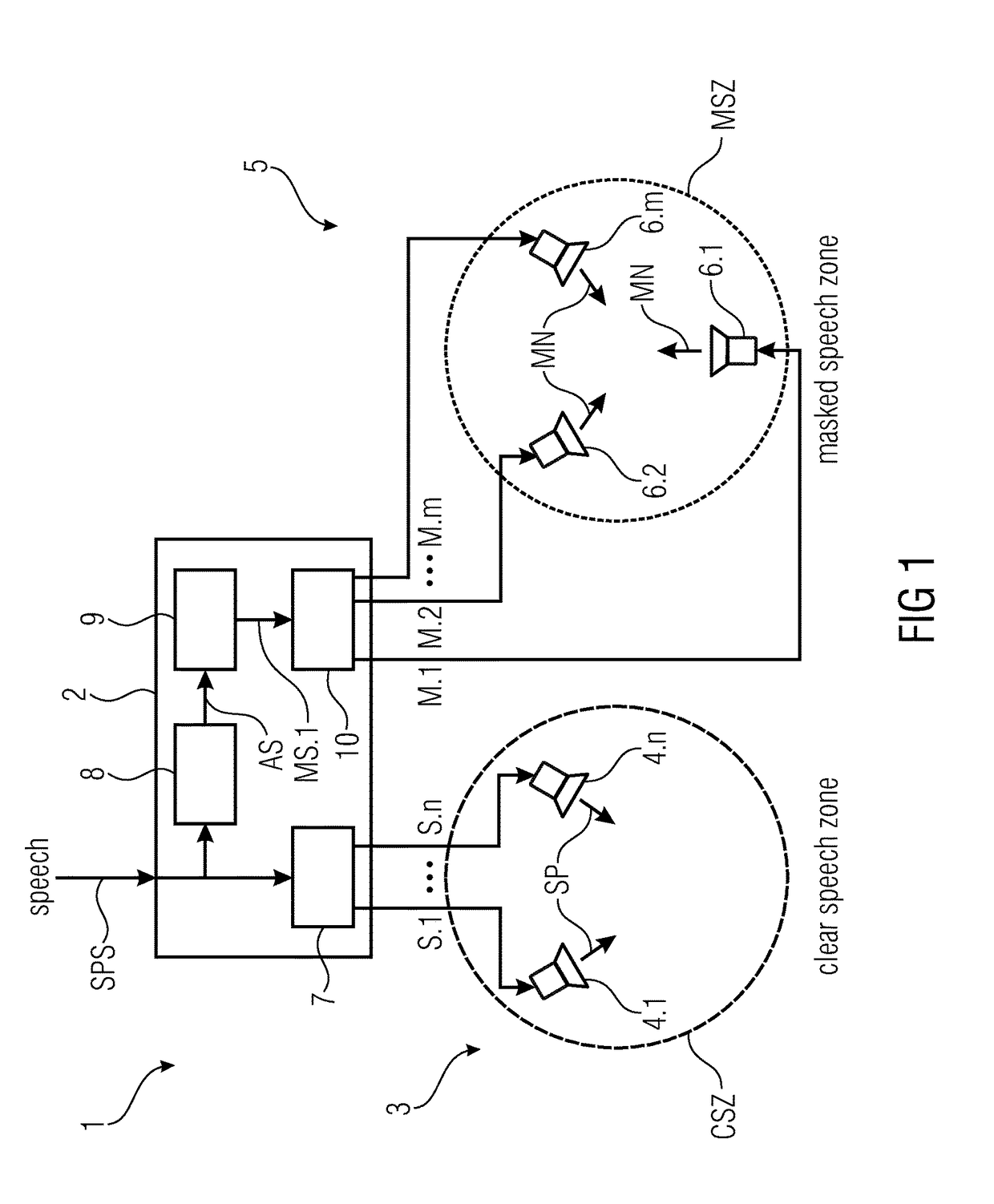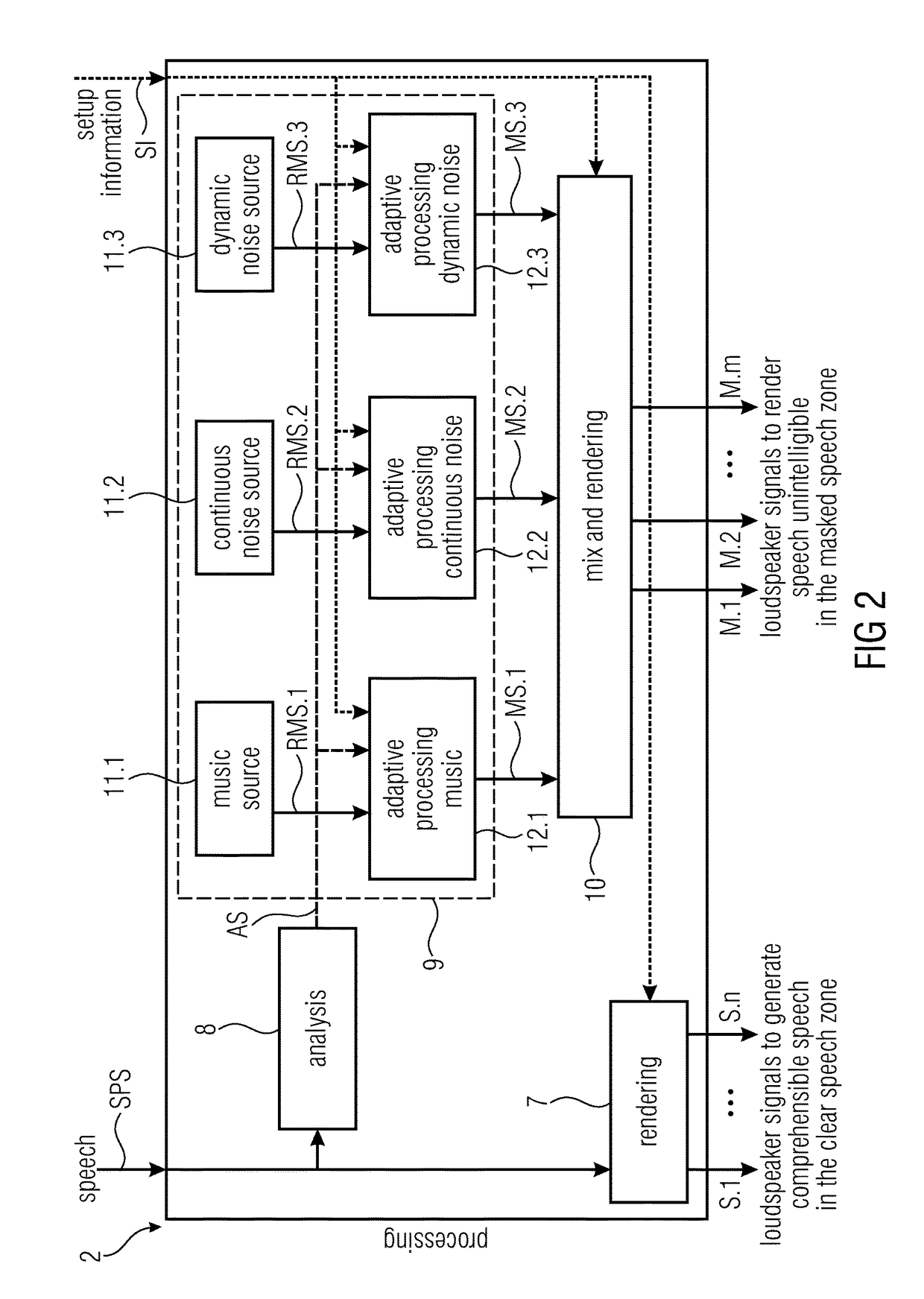Speech reproduction device configured for masking reproduced speech in a masked speech zone
a speech reproduction and masking technology, applied in the field of speech reproduction, can solve the problems of not only cancelling any signal reproduced but also local human speakers, and the system is inefficient in providing speech privacy, and achieves the effect of decent masking sound, low sound level, and convenient operation
- Summary
- Abstract
- Description
- Claims
- Application Information
AI Technical Summary
Benefits of technology
Problems solved by technology
Method used
Image
Examples
first embodiment
[0123]FIG. 1 illustrates a speech reproducing device 1 according to the invention in a schematic view. The speech reproduction device 1 is configured for reproducing speech SP based on a received speech signal SPS so that the reproduced speech SP is intelligible in a clear speech zone CSZ and unintelligible in a masked speech zone MSZ. The speech reproduction device 1 comprises:
[0124]an audio processing module 2 configured for receiving the speech signal SPS;
[0125]a set 3 of speech loudspeakers 4 configured for reproducing the speech SP based on one or more speech loudspeaker signals S; and a set 5 of masking sound loudspeakers 6 configured for producing a masking sound MN based on one or more masking sound loudspeaker signals M.1, M.2 . . . M.m, wherein the masking sound MN masks the speech SP in the masked speech zone MSZ;
[0126]wherein the audio processing module 2 comprises a speech loudspeaker signal producer 7 configured for producing the one or more speech loudspeaker signals ...
second embodiment
[0140]FIG. 2 illustrates a part of a speech reproducing device according to the invention in a schematic view.
[0141]According to an advantageous embodiment of the invention the masking sound generator 9 comprises a plurality of masking sound sources 11.1, 11.2, 11.3, 11.4 configured to provide a raw masking sound signal RMS.1, RMS.2, RMS.3, RMS.4 is and a plurality of raw masking sound signal adaption module 12.1, 12.2, 12.3, 12.4, wherein each of the raw masking sound signal adaption modules 12.1, 12.2, 12.3, 12.4 is assigned to one of the masking sound sources 11.1, 11.2, 11.3, 11.4, wherein the assigned masking adaption module 12.1, 12.2, 12.3, 12.4 is configured to adapt the raw masking sound signal RMS.1, RMS.2, RMS.3, RMS.4 of the respective masking sound sources 11.1, 11.2, 11.3, 11.4 based on the analysis signal AS in order to produce one of the one or more masking sound signals MS.1, MS.2, MS.3, MS.4.
[0142]According to an advantageous embodiment of the invention the at leas...
third embodiment
[0150]FIG. 3 illustrates a part of a speech reproducing device according to the invention in a schematic view.
[0151]A first modification of the embodiment described before is that an additional adaptive processing of the speech signal SPS is done by the adaptive speech processing module 13, wherein an adapted speech signal ASPS is used to produce the speech SP for the clear speech zone CSZ. Furthermore, in this embodiment, only two distinct masking components MS.1, MS.4 (i.e. music and noise) are used.
PUM
 Login to View More
Login to View More Abstract
Description
Claims
Application Information
 Login to View More
Login to View More - R&D
- Intellectual Property
- Life Sciences
- Materials
- Tech Scout
- Unparalleled Data Quality
- Higher Quality Content
- 60% Fewer Hallucinations
Browse by: Latest US Patents, China's latest patents, Technical Efficacy Thesaurus, Application Domain, Technology Topic, Popular Technical Reports.
© 2025 PatSnap. All rights reserved.Legal|Privacy policy|Modern Slavery Act Transparency Statement|Sitemap|About US| Contact US: help@patsnap.com



